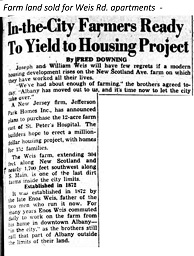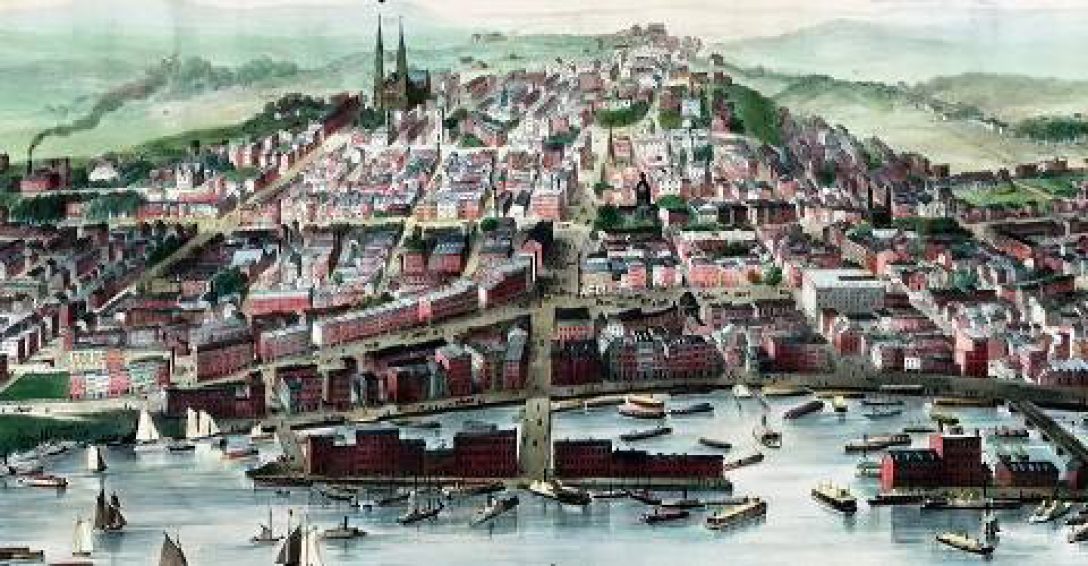At the beginning of the 1800s there was nothing on the New Scotland Plank Rd. but farmland, woods and fields. The first buildings we know are an inn, the Log Tavern* at the corner of Krumkill Rd.-a stopping point for the farmers going to and from the city, and a couple of farmhouses. The Plank Rd. was a toll road with several tollgates – one just beyond Ontario St. and another near what’s now the Golf Course.
 In 1826 the Almshouse (poor house) was established in the area that today is bounded by New Scotland Ave., Holland Ave., Hackett Blvd. and Academy Rd. (Back then the other 3 streets didn’t exist.) The next building to be constructed, in the 1840s, was the Penitentiary. (The VA Hospital is there now; built in the late 1940s, after the Penitentiary was razed in the 1930s.)
In 1826 the Almshouse (poor house) was established in the area that today is bounded by New Scotland Ave., Holland Ave., Hackett Blvd. and Academy Rd. (Back then the other 3 streets didn’t exist.) The next building to be constructed, in the 1840s, was the Penitentiary. (The VA Hospital is there now; built in the late 1940s, after the Penitentiary was razed in the 1930s.)

In the 1870s William Hurst established Pleasure Park, a popular and successful horse race trotting track and picnic area near Whitehall Rd. and New Scotland Ave. (He later went on to own the Log Tavern.)

 But Albany was growing – moving west, out Lydius St. (now Madison Ave.). In the early 1860s the area around the intersection of Madison and New Scotland started to see development, and a little stub of New Scotland Rd. from Madison to Myrtle Ave. was known briefly (for about 15 years) as Lexington Ave. In 1871 Washington Park opened and the area became fashionable. By the 1880s the Park trustees decided build a house for the Park’s Superintendent, as well as an array of greenhouses, on what is now the corner of Holland Ave. and New Scotland.
But Albany was growing – moving west, out Lydius St. (now Madison Ave.). In the early 1860s the area around the intersection of Madison and New Scotland started to see development, and a little stub of New Scotland Rd. from Madison to Myrtle Ave. was known briefly (for about 15 years) as Lexington Ave. In 1871 Washington Park opened and the area became fashionable. By the 1880s the Park trustees decided build a house for the Park’s Superintendent, as well as an array of greenhouses, on what is now the corner of Holland Ave. and New Scotland.
 Yet development west of Myrtle Ave. was slow. In 1893 the Dudley Observatory ** moved from Arbor Hill to New Scotland and South Lake Ave. In the late 1890s Albany Hospital was bursting at the seams in its downtown location at Eagle and Howard Streets, and moved to New Scotland Ave. About a decade later the Albany Orphan Asylum moved to what is now the corner of Academy Rd. and New Scotland Ave. (from Robin St. and Western Ave.). Today the buildings house the Sage College of Albany. It was originally known as the Junior College of Albany when it first opened in 1959.)***
Yet development west of Myrtle Ave. was slow. In 1893 the Dudley Observatory ** moved from Arbor Hill to New Scotland and South Lake Ave. In the late 1890s Albany Hospital was bursting at the seams in its downtown location at Eagle and Howard Streets, and moved to New Scotland Ave. About a decade later the Albany Orphan Asylum moved to what is now the corner of Academy Rd. and New Scotland Ave. (from Robin St. and Western Ave.). Today the buildings house the Sage College of Albany. It was originally known as the Junior College of Albany when it first opened in 1959.)***

 But within the decade residential and commercial growth exploded. Much of the land near the intersections of South Lake Ave. and Academy Rd. **** was owned by the Albany Driving Association, a private club that had a track for trotter horse races to the west of Academy Rd. The members decided to sell their vast tract of land (between New Scotland and what is now Hackett Blvd. and Forest Ave.) and established the Woodlawn Park development.
But within the decade residential and commercial growth exploded. Much of the land near the intersections of South Lake Ave. and Academy Rd. **** was owned by the Albany Driving Association, a private club that had a track for trotter horse races to the west of Academy Rd. The members decided to sell their vast tract of land (between New Scotland and what is now Hackett Blvd. and Forest Ave.) and established the Woodlawn Park development.
 Steadily residential growth pushed west. Yet there was no trolley service. The first bus service started about1914 – the “terminal” was at the intersection of South Allen St. and New Scotland. But this was a “suburban” area deliberately designed to accommodate the automobile as the primary means of transportation.
Steadily residential growth pushed west. Yet there was no trolley service. The first bus service started about1914 – the “terminal” was at the intersection of South Allen St. and New Scotland. But this was a “suburban” area deliberately designed to accommodate the automobile as the primary means of transportation.


By 1920 the Troop B Armory was constructed next to the Orphan Asylum. (Today it’s part of the Sage College Campus.) In 1921 Memorial Grove (the corner of South Lake and New Scotland) was created to honor the men who died in World War I.
 And that’s how New Scotland Ave. grew. By the mid-1920s there was a fire house, a public school, and Catholic Church. By the early 1930s St. Peter’s Hospital re-located to its current spot, from North Albany. The Depression initially halted residential development, but by the late 1930s the area beyond Manning Blvd. became a highly desirable location. It was zoned residential and the municipal golf course had been built just outside the city limits in 1931. Well-off families flocked to developments with enticing names -Golden Acres, Heldervale and Buckingham Gardens. Albany annexed land in Slingerlands several times and the city border pushed close to Whitehall Rd.
And that’s how New Scotland Ave. grew. By the mid-1920s there was a fire house, a public school, and Catholic Church. By the early 1930s St. Peter’s Hospital re-located to its current spot, from North Albany. The Depression initially halted residential development, but by the late 1930s the area beyond Manning Blvd. became a highly desirable location. It was zoned residential and the municipal golf course had been built just outside the city limits in 1931. Well-off families flocked to developments with enticing names -Golden Acres, Heldervale and Buckingham Gardens. Albany annexed land in Slingerlands several times and the city border pushed close to Whitehall Rd.
1930s New Scotland Ave









University Heights
 In the early 1930s Holland Ave. was created. ( It was once the route for the Mohawk- Hudson Railroad, chugging from the Point at Madison and Western Avenues. to downtown.) The Almshouse was demolished, making way for the Law School to move from State St,. the Pharmacy College from Eagle St. and a NYS Health Dept. Laboratory was built across from the Hospital. University Heights was almost complete. Then Christian Brothers Academy moved uptown from Howard St. and the Fort Orange American Legion Post ** was built next to Memorial Grove.
In the early 1930s Holland Ave. was created. ( It was once the route for the Mohawk- Hudson Railroad, chugging from the Point at Madison and Western Avenues. to downtown.) The Almshouse was demolished, making way for the Law School to move from State St,. the Pharmacy College from Eagle St. and a NYS Health Dept. Laboratory was built across from the Hospital. University Heights was almost complete. Then Christian Brothers Academy moved uptown from Howard St. and the Fort Orange American Legion Post ** was built next to Memorial Grove.





1940s and 1950s
 The next spurt of development began after World War II. There was a severe post-war housing crisis in Albany – the last farm within the city limits was sold in 1947 for the Weiss Rd. apartments. Hundreds of houses were constructed in the area surrounding New Scotland Ave. west of Manning to accommodate growing families with baby boomers. Two churches, St. Catherine’s Roman Catholic (now Mater Christi) and Bethany Reformed, were built in the 1950s and Temple Israel re-located to New Scotland in 1953. Maria College opened in 1965.
The next spurt of development began after World War II. There was a severe post-war housing crisis in Albany – the last farm within the city limits was sold in 1947 for the Weiss Rd. apartments. Hundreds of houses were constructed in the area surrounding New Scotland Ave. west of Manning to accommodate growing families with baby boomers. Two churches, St. Catherine’s Roman Catholic (now Mater Christi) and Bethany Reformed, were built in the 1950s and Temple Israel re-located to New Scotland in 1953. Maria College opened in 1965.
 After the annexation of Karlsfeld and Hurstville in 1967 New Scotland Ave. was complete and extended to the Normanskill.
After the annexation of Karlsfeld and Hurstville in 1967 New Scotland Ave. was complete and extended to the Normanskill.




1960s and 1970s


2000s



*The Log Tavern morphed into the Hurst Hotel, and became a favorite romantic rendezvous and “love nest”, especially for politicians’. It was destroyed by fire on election night, 1929. (Oh the irony.)

** The Dudley Observatory and Bender Laboratory (behind the Obeservatory) and the Legion post were demolished in 1970 to build the Capital District Psych Center and the attached parking garage.
***In the 1959 Russell Sage College purchased some of the buildings of what was then known as the Albany Home for Children and established the Junior College of Albany. In 2001 the College began offering 4 year degrees at the site, as the Sage College of Albany.
**** Academy Rd. was initially known as Highland Ave. – the name changed in the 1930s when Boy’s Academy moved from downtown.
Copyright 2021 Julie O’Connor












